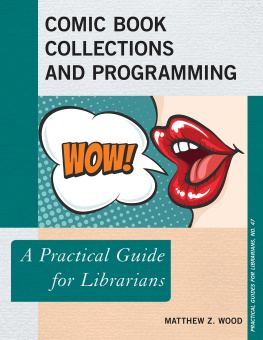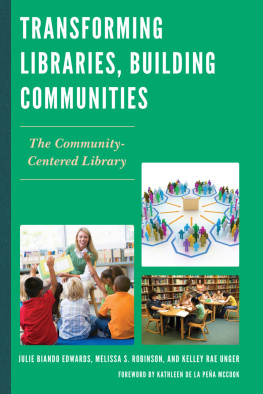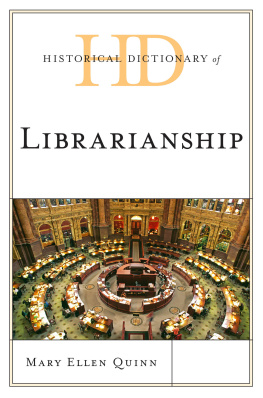AUDIO RECORDERS TO ZUCCHINI SEEDS
Building a Library of Things
Mark Robison and Lindley Shedd, Editors

Copyright 2017 Mark Robison and Lindley Shedd
All rights reserved. No part of this publication may be reproduced, stored in a retrieval system, or transmitted, in any form or by any means, electronic, mechanical, photocopying, recording, or otherwise, except for the inclusion of brief quotations in a review, without prior permission in writing from the publisher.
Library of Congress Cataloging-in-Publication Data
Names: Robison, Mark (Mark D.), editor. | Shedd, Lindley, editor.
Title: Audio recorders to zucchini seeds : building a library of things / Mark Robison and Lindley Shedd, editors.
Description: Santa Barbara, California : Libraries Unlimited, an Imprint of ABC-CLIO, LLC, [2017] | Includes index.
Identifiers: LCCN 2016056960| ISBN 9781440850196 (hardcopy : acid-free paper) | ISBN 9781440850202 (ebook)
Subjects: LCSH: LibrariesSpecial collectionsNonbook materials. | Special librariesCollection development. | LibrariesUnited StatesCase studies.
Classification: LCC Z688.N6 A93 2017 | DDC 025.2/1dc23
LC record available at https://lccn.loc.gov/2016056960
ISBN: 978-1-4408-5019-6
EISBN: 978-1-4408-5020-2
21 20 19 18 17 1 2 3 4 5
This book is also available as an eBook.
Libraries Unlimited
An Imprint of ABC-CLIO, LLC
ABC-CLIO, LLC
130 Cremona Drive, P.O. Box 1911
Santa Barbara, California 93116-1911
www.abc-clio.com
This book is printed on acid-free paper 
Manufactured in the United States of America
Contents
Mark Robison and Lindley Shedd
Adam Broner
James Hill
Jill Youngs
Ren Tanner and Betsy Goodman
Sue Kirschner
Michelle Coleman Alvarado, Justin Azevedo, and Amy Calhoun
Brian Burns
Jennifer Harvey and Rochelle Hunt Krueger
Shelly McCoy
Mitchell Shuldman
Tara Radniecki and Patrick Tod Colegrove
Diane Robson, Sue Parks, and Erin DeWitt Miller
Eric D. M. Johnson
Celia Rozen, Helen Woods, and Ed Kazzimir
Lindley Shedd and Mark Robison
Acknowledgments
The editors would like to thank all our contributors: Michelle Coleman Alvarado, Justin Azevedo, Adam Broner, Brian Burns, Amy Calhoun, Patrick Tod Colegrove, Betsy Goodman, Jennifer Harvey, James Hill, Eric D. M. Johnson, Ed Kazzimir, Sue Kirschner, Rochelle Hunt Krueger, Shelly McCoy, Erin DeWitt Miller, Sue Parks, Tara Radniecki, Diane Robson, Celia Rozen, Mitchell Shuldman, Ren Tanner, Helen Woods, and Jill Youngs. These authors are nobly experimenting with great ideas in their libraries.
We would also like to thank Sharon Coatney and Lise Dyckman at ABC-CLIO for seeing this project through, from the generation of concept until the moment the book hit the presses.
We owe a special thank you to Patricia Ratkovich for her skill in interpreting cataloging jargon to noncatalogers.
We also want to thank the University of Alabama Libraries and the Christopher Center Library Services at Valparaiso University for their support of this project.
Finally, Mark Robison would like to thank his friends and familyespecially his husband, Mattfor their insights about things collections and for their willingness to have yet another conversation about the cool things that libraries are doing. He wishes his grandmother, Marjorie Robison, who first taught him to love libraries, were here to see this book in print. He also owes a debt of gratitude to Ann Bourne, who graciously provided her sun porch as a makeshift office.
Lindley Shedd would like to thank family, friends, and colleagues for their encouragement and support, especially her partner, Paul Francoeur, for his never-ending encouragement and much-needed reminders to stop, eat, and rest as this project moved toward its completion. She would also like to thank her grandmother and aunt, Dorothy Taylor and Maude Carruth. Both women have been Lindleys lifelong supporters, making this project just another thing (but a big thing), which makes all the checking in and you can do its all that much more important.
Introduction
Attentive observers of todays library landscape will agree that a new movement is under way. Across the United States, libraries of all types are experimenting with building collections of items that defy tradition and expectation. The things collection movement is here. From the public library lending guitars and cake pans to the academic library offering umbrellas and green screens, libraries are reimagining and reinventing their roles by making things available for circulation to their users.
In contrast to the printed and audiovisual media so long associated with libraries, these things are not sought for their informational value. Instead, they typically serve a practical purpose as tool, equipment, or good. Consider, for example, the burgeoning seed library movement, exemplified by libraries such as the Pima County Public Library (Arizona), the La Crosse Public Library (Wisconsin), or Arizona State University. Seed collections put actual, sowable seeds into the hands of their patrons. Seeds might include those for growing edible fruits and vegetables, local flowers, and even grasses and varieties of wheat. In exchange, patrons are expected to save and to return a portion of the seeds from the plants they grow, to replenish the seed collection. In the process, patrons learn about gardening, seed saving, food sustainability, and other aspects of horticulture by way of workshops sponsored by the library. They also help to cultivate plants that are adapted to the local environment and promote genetic diversity among plants. The seeds in these collections are not some clever ploy invented by librarians to trick patrons into checking out gardening booksalthough many seed libraries do make such materials available. Rather, the circulation of seeds is the end goal itself. Though not a printed or electronic publication medium, seeds serve important practical and educational purposes to a librarys community of users.
Another example of this movement is the growing number of academic libraries that collect and circulate video game consoles. Examples include the University of North Texas Media Library, DePaul University Library, and College Library at the University of Wisconsin-Madison. Although innumerable libraries offer video games, most fail to take the next step of lending the actual equipment that would allow patrons to play the games in the comfort of their own homes (or dorm rooms). This trend is attributable to many factors, including the growing academic emphasis on gamification and new literacies, such as technology literacy and media literacy (Alexander, 2009; Apperley & Beavis, 2013; Sanford & Madill, 2007). But it also speaks to librarians valiant creativity and willingness to experiment with new services. As libraries have done for generations, these institutions identified a need among their patrons and satisfied it by acquiring, describing, and circulating a collection of items. Only these items are video games and consoles, instead of books.
From bicycles to sewing machines, from violins and ukuleles to prom dresses, libraries are recognizing the value of building new types of collections for their patrons. This introduction starts by defining what things collections are and explaining why they deserve to be distinguished from other library collections. It then situates the movement in the larger cultural and library landscape. We argue that this movement is closely tied to the rise of the digital sharing economy and its focus on sustainability and local community. Things collections are also influenced by the do-it-yourself (DIY) mentality and by DIYs revival through the makerspace. We believe the cultivation of things collections is one way that libraries are demonstrating their value to stakeholders. More than 20 years into the information age, having shed many of their traditional roles, libraries are working to define their new objectives and to reassert their importance to their communities in new and creative ways. Lending things is one such way that libraries can leverage their strengths to provide innovative and truly beneficial service to their users. This introduction closes with an overview of the contributed chapters that follow.
Next page







